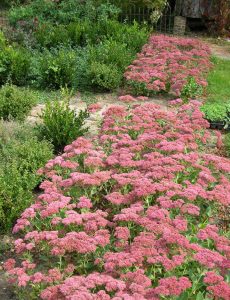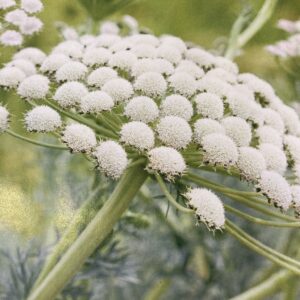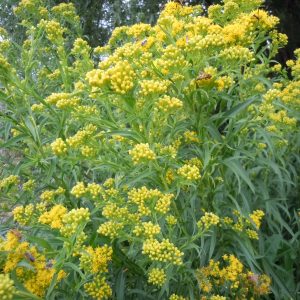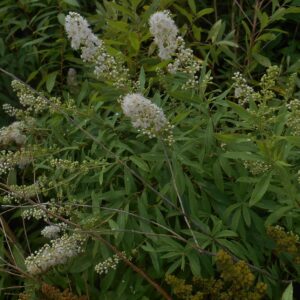Deer Resistant Plants
Showing 129–136 of 155 results
-
Scutellaria diffusa Turkish skullcap Z 5-10
Small snapdragonish violet flowers with white markings on two adjacent lower lips looking like an open book in summer along short stems. Flower clusters top tidy mounds of sage-colored, oval, hairy leaves.
OUT OF STOCK
Small snapdragonish violet flowers with white markings on two adjacent lower lips looking like an open book in summer along short stems. Flower clusters top tidy mounds of sage-colored, oval, hairy leaves.
Size: 4-6” x 12”
Care: sun in well-drained soil
Native: Turkey, Lebanon and Syria
Wildlife Value: deer resistantFirst published by Swiss botanist A.P.de Candolle in Prodr. 12: 421 (1848)
-
Scutellaria incana syn. Scutellaria canescens, Scutellaria villosa Downy skullcap Z 5-8
Showy, open spikes of two-lipped Blue-violet florets from June-Sept
Flowers of spikes of purple-blue tubes ending in two open lips, the lower lip having a white blotch, blooming for months from July to September, if deadheaded
Size: 2-3’ x 12-18"
Care: sun to part shade in moist well-drained to well-drained soil. Reblooms if deadhead after 1st flush of flowers
Native: NY to WI, Georgia to TX, Wisconsin native
Wildlife Value: Deer resistant. Its nectar feeds small butterflies, Bumblebees and Hummingbirds.The name Scutellaria is from Latin scutella meaning a small dish or saucer referring to the shape of the persistent calyx, a covering at the flower’s base. Incana means grey referring to the tiny hairs on stems and undersides of leaves giving a greyish color. Named by Johann Friedrich Theodor Biehler, German botanist from the plant specimens in Christian Sprengel’s (1750-1816) herbarium in 1807. How did German botanist Sprengel, who never set foot in America, come to have a pressed specimen of this native American plant? Sprengel and German botanist Carl Ludwig Willdenow (1765-1812) were close collaborators. Another German botanist Heinrich Ernst Muhlenberg (1753-1815), living in Lancaster Pennsylvania, sent many American plants specimens to Willedenow. Scutellaria incana is native to and grows in what is now called Muhlenberg Meadow in Lancaster County PA. These connections make it likely that the specimen Biehler saw came from Henry Muhlenberg.
-
Scutellaria resinosa syn. Scutellaria wrightii Prairie skullcap Z 4-9
Two-lipped, deep violet-blue tubes bloom from spring to fall
Two-lipped, deep violet-blue tubes bloom from spring to fall
Size: 10” x 10”
Care: sun to part shade in well-drained to moist well-drained soil, drought tolerant
Native: Colorado, NM, KS, Oklahoma, TX, collected on the Canadian River, tributary of Arkansas River
Wildlife Value: deer & rabbit resistant. Nectar and pollen attract butterflies and bees.Described by botanist John Torrey in Annals of the Lyceum of Natural History of NY 2: 232 (1828)
-
Sedum ‘Autumn Joy’ syn ‘Herbstfreude’ syn Hylotelephium ‘Autumn Joy’ Z 4-9
Classic, large flat flower heads turn from green to rose
Classic, large flat flower heads turn from green to rose blooming in September and October. A staple for autumn in the garden.
Size: 30” x 12”
Care: full sun in well-drained soil
Awards: England’s Royal Horticultural Society Award of Garden Merit.Sedum means “plant that sits.” “Live forever” is an ancient Greek name for sedums. The Roman Pliny claimed that sedum’s juice treated wounds. In the 1500’s English herbalist Gerard called sedums “very full of life,” referring to succulent’s quality of being very easy to grow. Autumn Joy introduced to gardens before 1920 by the George Arends Nursery in Ronsdorf, Germany.
-
Seseli gummiferum Moon carrot Z 5-9 self-seeding biennial or short-lived perennial.
Five-inch diameter mound of many circles of pale pink to white flowers atop silvery, frilly, fern-like foliage flowering in mid-summer into early fall.
Five-inch diameter mound of many circles of pale pink to white flowers atop silvery, frilly, fern-like foliage flowering in mid-summer into early fall.
Size: 2-3’ x 12-18”
Care: Sun to part-shade in well-drained to moist well-drained soil
Native: Crimea, Turkey and South Aegean
Wildlife Value: Deer resistant. Butterfly magnet; host for caterpillar of Eastern swallowtail butterfly.Seseli is an ancient Greek name of an umbelliferous plant. This species first described by Linnaeus in 1735. In Re classified and renamed in 1830 in Prodromus systematis naturalis regni vegetabilis, sive, Enumeratio contracta ordinum generum specierumque plantarum huc usque cognitarium, juxta methodi naturalis, normas digesta.
-
Sesleria autumnalis Autumn Moor Grass Z 5-9
Fresh-green spring narrow blades of grass in summer add airy purplish flower spikes with silver-white stamens on this low mounding, arching grass. Blades have a striking yellow-green color that sometimes develops a soothing golden autumn tint. Spike-like silvery flowers rise above the leaves and mature into soft tan seed heads by autumn.
Fresh-green spring narrow blades of grass in summer add airy purplish flower spikes with silver-white stamens on this low mounding, arching grass. Blades have a striking yellow-green color that sometimes develops a soothing golden autumn tint. Spike-like silvery flowers rise above the leaves and mature into soft tan seed heads by autumn.
Size: 9-24” x 12-18”
Care: sun to part shade in moist well-drained to well-drained soil, drought tolerant
Native: SE Europe east to Caucusus
Wildlife Value: walnut, salt and deer tolerant
Awards: Royal Horticultural Society Award of Garden Merit. Gardens Illustrated “100 Must-Have Garden Plants,” 2013.Collected in Slovenian mountains near Idria, c. 1760 by and 1st described in Flora Carniolica by Giovanni Antonio Scopoli (1723-1788) physician, naturalist and author. Sesleria is named to honor Leonardo Selser, 18th century Italian botanist and physician, contemporary and likely friend of Scopoli
-
Solidago riddellii syn. Oligoneuron riddellii Riddell’s goldenrod, Stiff goldenrod Z 3-7
Sunshine yellow dome-topped flowers Sept.- Oct. Differs from S. gramnifolia by fewer leaves and its leaves fold toward the center vein.
Sunshine yellow dome-topped flowers Sept.- Oct. Differs from S. gramnifolia by fewer leaves and its leaves fold toward the center vein.
Size: 3’x2’
Care: sun in moist to moist well-drained soil.
Native: swath down middle of No. Am. From Hudson Bay to AK, incl. Wisconsin native
Wildlife Value: Loved by butterflies for its nectar – Small copper, Monarch, Giant swallowtail, Gray hairstreak, Clouded Sulphur, Fritillary, Pearl crescent, & Cloudless sulphur. Attracts praying mantises. Resists deer.The name Solidago from solidus and ago meaning to bring together. First published by German botanist Joseph Frank who named it riddellii in honor of John Riddell who had collected it in Ohio before 1835.
-
Spiraea alba Meadowsweet, Du Roi Z 3-7
This short shrub sports white flower spikes 4” long blooming from June to August, deadhead for rebloom.
This short shrub sports white flower spikes 4” long, blooming from June to August, deadhead for rebloom.
Size: 3-4’ x 3-4’
Care: sun to part shade in moist to moist well-drained soil
Native: Northeastern 2/3 of North America, Wisconsin native
Wildlife Value: nectar attracts butterflies & hosts caterpillars of Spring azure butterflies1st described in literature in 1772. Algonquin made a medicinal tea with Meadowsweet’s leaves and stems. Iroquois administered a decoction of mashed and powdered dry roots to remedy pain in the sides.
**LISTED AS OUT OF STOCK BECAUSE WE DO NOT SHIP THIS ITEM. IT IS AVAILABLE FOR PURCHASE AT OUR RETAIL LOCATION.





